If you’re a proud owner of a garage or a workshop where you can cut metal bars, bend and shape them in different ways and then also weld them into large structures, you probably already know that whatever it is you come up with – you will need to sand to make it look decent.
The thing is, no matter how precise your cuts are, or how tidy your welding is, at the end of the day, there will also be some sort of imperfection that needs to be tackled so that the thing you’re making looks polished and refined. (This is especially important if you mean to sell this product.)
Anything from corrosion resistance to easier painting depends on the smoothness of the surface of the piece of metal you’re working on. So, if you are able to polish these metal pieces you’re using to build something, you will have much less work polishing them up once you’ve already welded them together or secured them with bolts, for example.
In this article, we’re going to present to you a special breed of machines that can help you get rid of all imperfections from the piece of metal you’re working on. Belt sanders, as their name suggests, use special belts of sandpaper that are then rotated at a certain speed, so that you can polish a piece of metal by gently pressing it against the moving sandpaper.
In the passages below, you’ll find a list of products among which we are confident you’ll be able to find the best belt sander for metalwork that would perfectly suit your needs.
Without further ado, here’s the deal.
Best Belt Sander for Metal Work – A List of Products
1. JET – J-41002 Bench Belt and Disc Sander
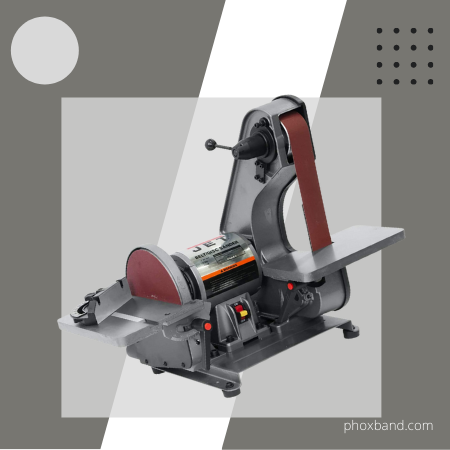
If you’re looking for a sturdy metal sander tool that you can use for a wide variety of metal-working purposes, this model from JET can be the perfect thing for you. This sander features a heavy-duty build that means you can use it to polish large pieces of metal with ease. (As long as they’re not so large that you cannot hold these in your hands.)
Construction-wise, this thing comes with a steel base, some rubber feet, and an overall sturdy cast iron construction. Once you set this thing up, you can rest assured that you won’t have to worry too much about it breaking at any point. Here are some of its other features:
Tilting belt sander – In case you need to sand off a piece of metal from your project, so to speak, but you can’t approach it because it’s a funny angle, the great news is that this disc sander will allow you to tilt the sander at 45° both to the left and right.
Adjustable dust chute – … helps prevent the dust particles from getting everywhere and creating a mess in your workshop.
Adjustable dust deflector – Since you can work at different angles thanks to the tilting mechanism of this belt sander, the protective dust deflector is also adjustable, so that it, well, ‘deflects’ dust away from you while you’re working.
- Comes with a heavy steel base
- Has rubber feet for extra stability
- Overall cast iron construction
- Can turn at a 45° angle both left and right
- Features a dust deflector and chute
- Excellent quality of the abrasive belt
- Changing the belt means you have to remove the table (which can be a tad annoying)
2. Bucktool – Combo Belt Sander, Bench Grinder & Knife Sharpener
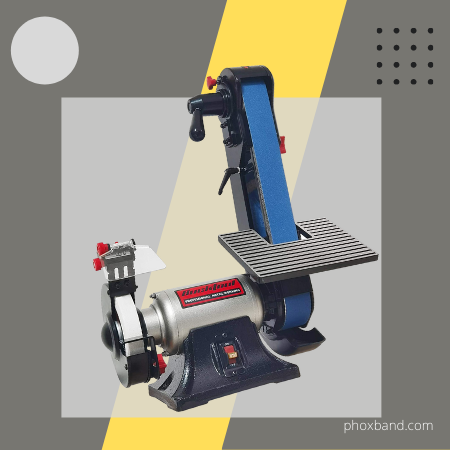
Representing possibly the best belt sander for metal in this price range, this Bucktool belt sander is not only a simple belt sander. It also doubles as a bench grinder, and you can even use it as a knife-sharpener. So, practically, you get three tools in one if you decide to purchase this product. Here are some of its most important properties.
Ease of use – One of the most important features of this model, at least when beginner users are in question, would certainly be how easy it is to use. Thanks to the adjustable eyeshield, as well as to the fact that changing the belt on this model is a piece of cake, you can use this thing for hours without worrying about any debris getting in your eyes. Also, when the sanding belt has run its course, you can change it easily in minutes.
Sanding at different angles – Being able to easily sand the metal objects you’re working on represents one of the most important features of a product that can be called the best metal sander. Rather than having to buy multiple sanders for every different angle you need to ‘cover’ in your projects, so to speak, you can achieve that with just one contraption.
Adjustable eyeshield – since this tool enables you to sand metal objects at different angles, the fact that the eyeshield can be adjusted easily in seconds to whatever position you need at the moment is a great touch by the folks at Bucktool.
- Tough, heavy-duty construction
- This tool meets all the CSA standards
- The belt can tilt from 0 – 90° for sanding at different angles
- Adjustable eyeshield (no tools required)
- Comes with two different workbenches
- Inbuilt LED light
- Safety switch key
- Some users may find this tool to be too bulky
3. Rockwell – Belt/Disc Combo Sander
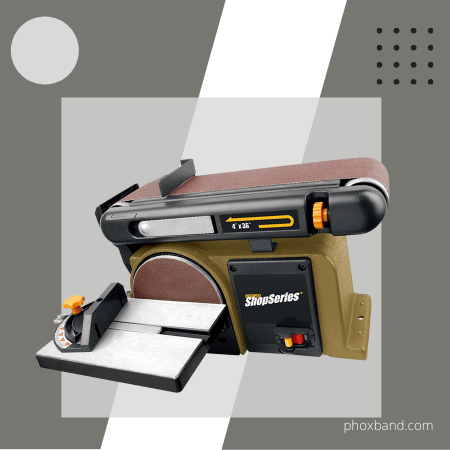
If you’re looking for a simple tabletop tool that you can use to quickly and precisely whittle down some of the excess metal parts of whatever it is you’re working on, this Rockwell machine could as well be the best belt grinder for metal work, considering its price, of course.
What makes this tool such a solid belt sander for metal work would be its heavy-duty induction motor that nevertheless doesn’t take too much space, so the overall size of this combo sander won’t take the entirety of your workshop bench. (If you decide to place it there, that is.) Here are some of the most prominent features of this tool:
Horizontal and Vertical Sanding – Sometimes it can be difficult to hit the right angle if all you have to work with is a horizontal sanding belt. This machine gives you both a horizontal AND a vertical surface, so you have two workable plains to use, so to speak.
Mighty induction motor – Mustering 4.3 Amps of electrical power, the induction motor the folks at Rockwell installed in this machine will be able to keep the sanding belt moving, no matter how hard you’re pressing a piece of metal against the belt. (Of course, you don’t want to press too hard for safety reasons.)
Simple belt changes – Once a belt has run its course, replacing it with a new one is a piece of cake. All you need to do is pull the quick-release tension lever that was specifically developed for this purpose, replace the belt, pop the lever back into position, and you’re good to go!
- Enables you to sand both horizontally and vertically
- Quick-release tension lever (for changing the belt)
- Comes with a powerful 4.3 Amps motor
- There’s a safety switch onboard that prevents accidental starts
- Some users have reported that some vibrations can occur if too much pressure is applied on the belt (this can be avoided by pressing metal objects against this sander gently)
4. WEN – Belt Sander with 5-Inch Sanding Disc
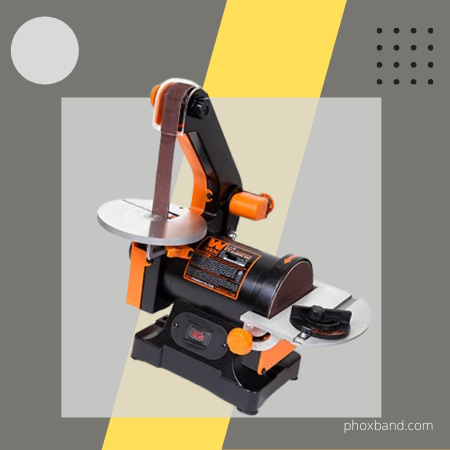
Representing a great example of a sturdy bench belt sander for metal, this WEN 2-in-1 tool can be a great option for a person in need of a sanding tool with both belts and discs. This model from WEN has both of these sanding tools, so you don’t need to buy another similar contraption to get your work done.
Since this tool has two separate rotating sanders, so to speak, the folks at WEN made sure that this tool is stable by building a heavy-duty base for it, so that the vibrations and movements during operation are brought to a minimum.
Miter gauge – … helps you cut all of the pieces of metal you’ve been working on precisely and easily, without worrying about cutting off too much.
Two separate dust collectors – Once you start using a belt sander, you’ll realize that you’ll end up producing quite a lot of metal shavings and metallic dust. This is why the folks at WEN decided to add two different dust ports,so you can vacuum them easily when you’re finished with your work.
Two-in-one design – The great thing about this contraption is that, other than the standard belt that comes with it, you can also count on the sanding disc, which you can use to shave off pieces of metal from the object you’re working on precisely and at different angles.
- Comes with a mitre gauge
- Heavy-duty base
- Features two dust ports
- The beveling table can be tilted at 45 degrees
- 2-year warranty
- Some users reported that this machine can be tough to assemble
5. Bucktool – Bench Belt Sander with ¾ HP Motor
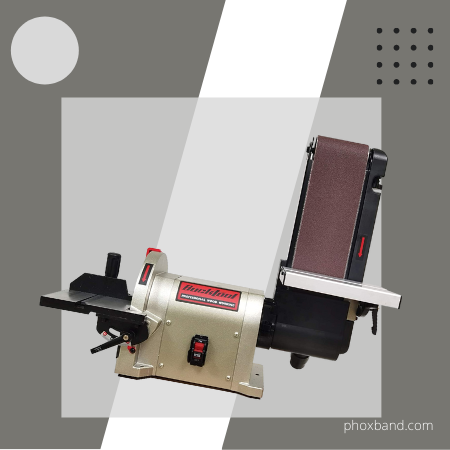
Most belt sanders don’t have their motor shaft attached directly to the belt sander mechanism, which tends to lower the efficiency to up to 25%. This model would be one of the belt sanders that does have the motor powering up the belt directly, which means you get to use much more of the motor power than with the other belt sanders out there on the market.
Since better efficiency means more power and a higher rotating speed, it’s also important for a sander to be stable and fixed on the surface below it to reduce vibrations. For this purpose, the folks at Bucktool made sure that this contraption is made out of a special cast aluminum base and that there are additional rubber feet for increased grip and stability.
Here are some of the other features this bench belt sander for metal comes with:
Working at different angles – … is important if you’re trying to get the piece of metal you’re working on to get a particular shape. This belt sander can be fixed at angles from 0 to 90° to enable you just this.
2-in-1 functionality – One of the arguably best things about this model would certainly be that you not only get a belt sander, but also a disc sander, so you have more options to work with when it comes to the different pieces of metal you’re sanding.
2 dust ports – Since this model comes with a disc sander in addition to the disc sander, there are two dust ports, so that both of these mini ‘workstations’ can be dust-free as you’re using them to sand off excess pieces of metal.
- Motor-direct build that increases the efficiency up to 25%
- A powerful, ¾ HP motor
- 2-in-1 design (you get both a belt sander and a disc sander)
- A tough, aluminium base
- 2 dust ports
- Quick sander track replacement
- Some users complained that some parts on this machine are low-quality
6. WEN – 4.3-Amp Belt & Disc Sander with Cast Iron Base
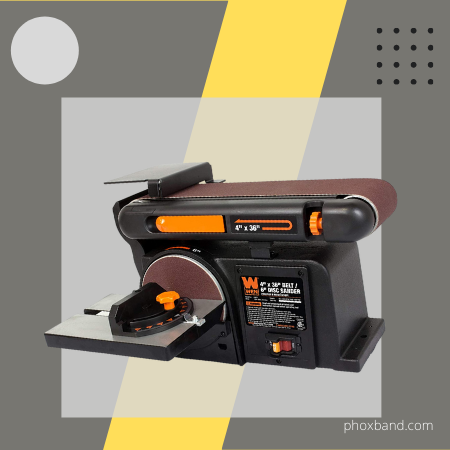
As the name of this product suggests, by purchasing this model from WEN, you’re not only getting a belt sander, but also an additional disc sander, so you have double the options to work with when it comes to sanding off unnecessary pieces of metal.
Although this model can’t be described as a full-on industrial belt sander for metal, it does have a sturdy build with a heavy base that’s made out of high-quality cast iron. This gives this machine excellent stability properties and can work wonders when it comes to different vibrations that tend to be present while working with any belt or disc sander.
Here are some of the most important features of this model:
Excellent sanding versatility – In case a solitary belt sander won’t cut it for you and you need more sanding tools to get your job done, this model can be a perfect option for you since it comes with a fully functional disc sander in addition to the stock belt sander.
Tilting belt – Although the pictures of this model display the belt sander reclining on the base of the machine completely horizontally, you can rest assured that you can tilt it upwards to up to 90°.
A mitre gauge – … will help you get rid of all the guesswork when it comes to the measuring of what you can and cannot sand. Thanks to this gauge, all you need to do is simply place the piece of metal you’re working with against it and you’ll never need to worry about cutting off too much material again.
- A 4.3-Amp motor
- Comes with an additional disc sander (gives you more sanding options to work with)
- A tilting belt allows you to work at different angles
- Simple sandpaper changes thanks to an easy-to-use pressure release lever
- A sturdy cast-iron base for increased stability
- Comes with a mitre gauge
- Some users reported some issues with overheating with this unit
Benefits Of A Good Belt Sander

- Belt sanders are light compared to other types of sanders – this means they are taken out and stored quickly. If all you’re looking to do is a quick finish to pieces and surfaces of standard materials, then you would do well to look at belt sanders.
- Belt sanders are light and compact, which means that they are maneuverable. With a belt sander, you can reach difficult spots with ease, and you have more control to cover smaller areas more accurately.
- The way belt sanders are made and how they perform makes them the premier choice for removing undesirable residue on any surface. A belt sander can easily take out paint or varnish while maintaining the underlying finish of the material when configured to the right settings and in a steady but firm hand.
- Belt sanders are built to operate at higher speeds so that they can do sanding jobs quicker than other types of sanders. Workers prefer to use belt sanders to do an initial major sanding run before any fine details are addressed. A belt sander is one of the most useful tools. You can use it in many types of sanding jobs such as sanding deck, furniture, hardwood floor, floorboards, or DIY jobs. You can also use it for a small shop or home use, fine homebuilding.
Benefits Of Belt Disc Sanders
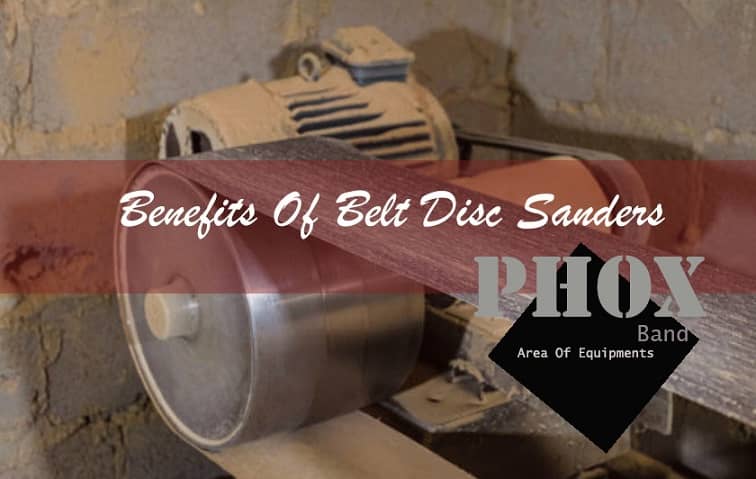
Buying a belt disc sander is cost-efficient. Even if it costs higher than a belt sander or a disc sander, it actually costs cheaper in the long run than buying one of each type of sander combined.
Choosing a belt disc sander not only saves you money but also time and energy. This is because you don’t have to come running to a home depot looking for a disc sander upon realizing that the belt sander that you bought for your last project does not support your need for the next project. Having a 2-in-1 sander takes away that worry.
Since belt disc sanders run two types of sanders, they are expected to work on large woodwork projects. It can accommodate the majority of a woodworker’s needs for great results.
Pros
- Stationary – Most belt disc sanders are designed stationary—the reason why it weighs a good number of pounds. With this, it gives the woodworker smooth and consistent work for not giving him or her a hard time putting in the right place.
- Heavy-duty – Belt disc sanders are also intended to be used for any type of woodwork. They are meant to last long and will still work after countless projects have been done with it.
- Serviceable – Since belt disc sanders consist of both belt and disc sanders, they are expected to be used most of the time. They are indeed ready-to-use and practical instead of having one belt sander and another disc sander.
Cons
- Storage – Having belt disc sanders may give you a headache where to store them. They are actually bigger for having two types of sanders in one.
Things To Look For When Choosing A Belt Sander
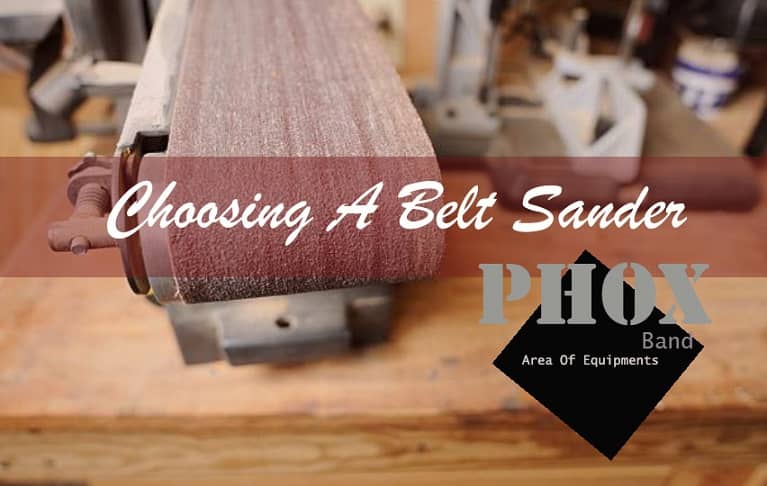
Check the front nose of the belt sander. If you’re looking to do some work with softwoods and work that requires more detail such as small holes, then you would need to look for a belt sander whose front nose is more exposed and rounded.
Look for a belt sander with a dedicated system for track centering. This ensures that no matter how fast the motor is running, the best stays in place, but most of all, the belt stays centered.
Most, if not all belt sanders come with an appropriate vacuum and a detachable bag where all the dust and other residues should go. Check to make sure this feature does not interrupt your movement.
Belt sanders are more portable, but does yours have some heft to it ? You may not realize it at first, but some extra weight on a belt sander guarantees that you wouldn’t need to push as hard to make the device smooth out a surface.
Your belt sander should ideally be operated with a grip resembling a pistol, complete with a trigger. Test the trigger to make sure that it locks so that you can keep the belt sander running without having to keep one finger pressing it.
RELATED POST: A Guide To The Belt Sander Dust Bag
Tips On Using A Belt Sander
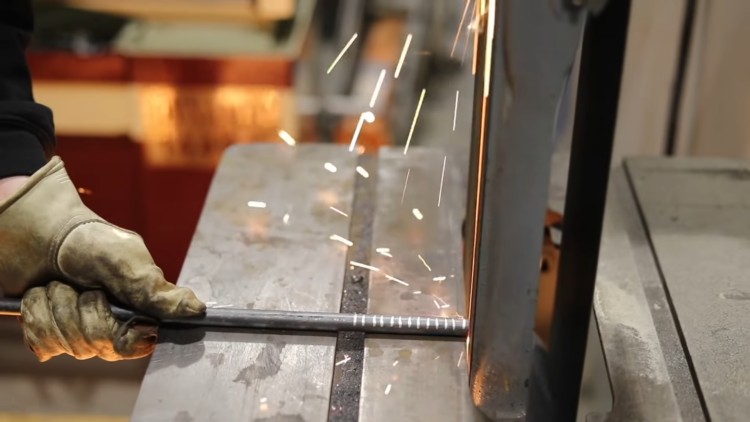
Be Consistent In Preparation – Put in a fresh and a new piece of sandpaper before you start the day. Make sure there are no furls or loops in the power cord for fewer interruptions as you move around. Have the right protective gear on. Make sure the dust bag is empty.
Be Aware Of The Sandpaper You’re Using – Always remember that the rougher the grit of the sandpaper you place on the belt sander, the quicker you can deal with rough surfaces – but, on the other hand, you will need to switch to sandpaper with much finer grit to really make the surface as smooth as it should be. At any rate, you would do well to test the sander and the sandpaper on some scrap wood or material before you put it to work on the actual surface.
Be Diligent In Practice – Though you can use a belt sander right out of the box with ease, it does take just a little bit of practice for you to use the tool effectively, to the point that it becomes an extension of your body. The more you use the belt sander, the more you will see that the material you are smoothing has much more chance of getting damaged than your body and the more confident you will get in using it for more projects.
Be Innovative And Creative With Your Belt Sander – Remember that your belt sander is more or less capable of sanding more than just wood – and the moment you realize this, you will appreciate your belt sander so much more. For instance, did you know that you could make knife edges or wood chisels sharper simply by running them the right way through your belt sander? This isn’t too unorthodox as you may believe, it’s just that you need to remember that it isn’t just a table that could benefit from a smooth surface.
Be Open For Advice – Sanding may have an initial reputation of being a monotonous chore, but if your ears are open for any suggestions in making the whole job easier with your belt sander, you will find out that there is a sense of pleasure and achievement to making sure that your project is finished appropriately. Take in as much advice as you could, from local acquaintances or online, preferably from those who have the same belt sander as you.
RELATED POST: Porter Cable 362V Belt Sander Review
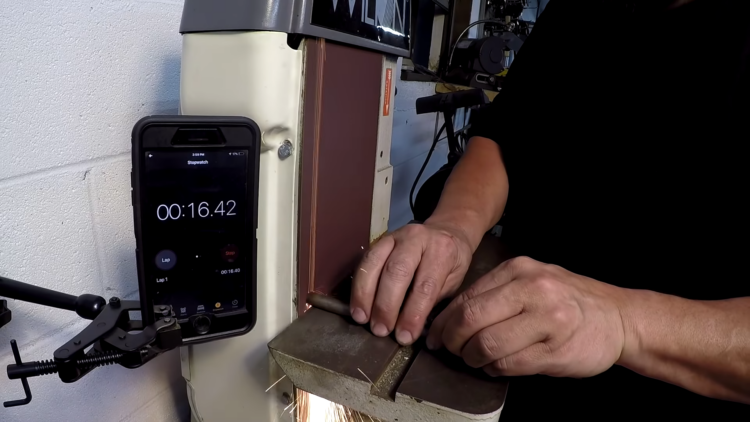
Frequently Asked Questions (FAQs)
1. What Do I Need To Wear When Using A Belt Sander?
It is advisable to wear something to protect your eyes. Safety goggles should be enough, but you may want to cover yourself further with a full face shield if you have one. If you’re going to be doing fine smoothing, wear a face mask to cover your nose and mouth as you work.
2. Does The Width Of The Belt Matter?
Most belt sanders are made to cover areas three inches wide at a time, and this should be enough, even for wider areas. You may want to buy belt sanders with wider reaches, but only if you’re sure that you will be using that whole area for the majority of upcoming projects you will have.
3. Does The Weight Of The Belt Sander Matter?
Most professionals will tell you that you shouldn’t apply excessive pressure on your belt sander, because most of the time, the weight of the belt sander should be enough to do a decent and consistent smoothing job.
4. How do you tilt the platforms/working tables?
There is actually a handle with numbers installed beside the platforms or working tables so you will know that you have adjusted the platforms or the working tables to your desired angles. You’ll just have to loosen up the handle, usually by rotating it, and move it on the angle of your preference. Tighten the handle back on to make sure that your platforms or working tables are steady.
5. Can it work if I use materials other than wood?
Yes, but you will have to use more abrasive sandpapers. Other materials, like glass, may take off the abrasive grits which may have you replace it for a new one.
Conclusion
All in all, even though the models we presented to you above aren’t so easy to work with that they could be lumped into the ‘handheld belt sander for metal’ category, they’re certainly small enough to comfortably sit at your workbench without taking up too much space.
Also, their sturdy bases suggest that you won’t have to do much in terms of reducing vibrations while working with these contraptions. We hope you found this article helpful and we wish you plenty of success with your sanding projects.
If these weren’t enough, check outsome other picks from Amazon also:

